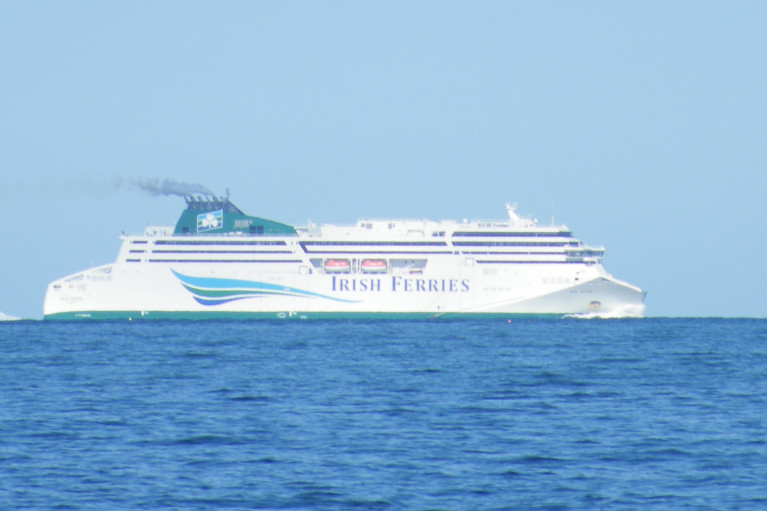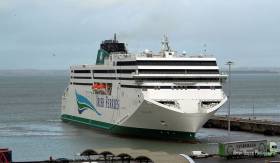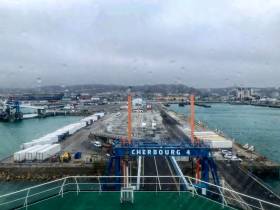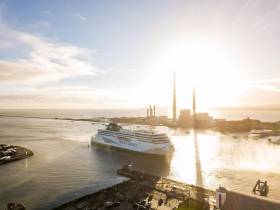Displaying items by tag: WB Yeats
Irish Ferries Boost Freight Capacity As W.B. Yeats Enters Service Early on Direct France Route
W.B. Yeats, the largest ferry operating out of Dublin Port has switched from the Holyhead route to Dublin-Cherbourg due to the continued surge in freight demand on direct routes to France, writes Jehan Ashmore.
The 165 freight accompanied unit capacity Irish Ferries ship began the Ireland-mainland Europe route last week though the cruise ferry was originally scheduled to enter service but not until 25 May, marking the traditonally busier summer season.
Irish Ferries early redeployment of the larger lorry-driver cabin capacity W.B Yeats on the French route led to the transfer of the chartered ropax Epsilon to return on the Dublin-Holyhead route. The smaller ropax works in tandem with the cruise ferry Ulysses though passenger demand on the Irish Sea is low given this quiet time of the year coupled with Covid-19 restrictions. While rivals, Stena Line recently implemented temporarily a reduction in sailings as Afloat reported due to supply-chain issues.
The swap of vessels between these routes is no surprise given the surge in demand experienced in Rosslare Europort where rivals Stena Line prior to the festive season stepped up capacity also to Cherbourg that was due to begin last Monday.
In addition the launch by DFDS new Rosslare route to Dunkirk on 2nd January is another indicator of such freight demand. The level in haulage capacity is to increase yet further when Brittany Ferries in March will also connect the Wexford ferryport and Cherbourg.
The Normandy port is not only proving a convenient and strategic port for Irish haulage firms and other customers using three ferry operators, as Brittany Ferries recently reintroduced the freight-only ferry Cotentin but serving the UK.
After an absence of 7 years for the French operator, Cotentin's Stena Line Baltic Sea service ceased late last year with the freighter returning to English Channel service sailing on New Year's Day on the Cherbourg-Poole route.
Cotentin is back due to the UK Department for Transport's contract for extra freight capacity on routes to France following Brexit and the consequent termination of the free trade agreement with the EU.
In April, Barfleur the route's routine ferry resumes service and will offer passenger capacity too.
W.B. Yeats returned to the Irish Sea following a scheduled routine dry-docking in France which sees the cruiseferry operate the Dublin-Holyhead route over the winter months, writes Jehan Ashmore.
The 1,850 passenger/1,216 car and 165 lorry capacity W.B. Yeats on Friday departed Dunkerque (East) for the repositioning voyage back to Ireland.
Afloat.ie however tracked the 54,975 gross tonnage cruiseferry make an en route call to Cherbourg before completing with an overnight passage to Dublin Port. This involved an arrival on Saturday mid-morning.
Several hours later, W.B. Yeats resumed duties with the 14.30hrs sailing from the Irish capital. As previously reported on Afloat, ICG (parent company of Irish Ferries) have a 'contingency plan' with space set aside on the €144m cruiseferry for a post-Brexit duty-free shop though this depends on the nature of the UK's exit deal.
Also previously reported, W.B. Yeats completed a first season on the Dublin-Cherbourg route. Afterwards the cruiseferry took up service as scheduled for a brief spell on the Welsh route joining Ulysses. The ropax Epsilon, however from this service swapped with W.B. Yeats so to provide cover while the dry-docking took place in northern France.
The chartered in Italian flagged Epsilon continues as scheduled to maintain serving the direct year-round operated Ireland-France route for the winter. In the meantime this leaves the largest ferries of the company's fleet, Ulysses and W.B. Yeats sharing crossings on the Irish Sea central corridor service.
Sailings between the Irish capital and mainland continental Europe to be operated by W.B. Yeats for season 2020 begin on 28th March departing Dublin Port
W.B. Yeats Completes First Season on Ireland-France With Follow Up Dry-Docking in Dunkerque
W.B. Yeats has completed a first high-season on the year-round operated Dublin-Cherbourg route and the €144m cruiseferry built in 2018 made its inaugural dry-docking in France this morning, writes Jehan Ashmore.
Afloat tracked W.B. Yeats to Dunkerque (East) and taking its place on the direct Ireland-France route sailings is the ropax Epsilon. The 194m long W.B. Yeats was assisted by a pair of tugs, Aventereux and CB Cyclone into a dry-dock at the northern French port.
The considerably larger capacity of W.B. Yeats connecting the Irish capital and mainland continental Europe is a massive boost for Irish Ferries when compared to then Cartour Epsilon which launched the route in 2014. Since then the scenario of 'Brexit' highlights the direct route's strategic trade importance for Irish hauliers (albeit at the expense of Rosslare-France) in avoiding the UK 'land-bridge' via the Port of Dover.
At 54,975 gross tonnage, W.B. Yeats is easily the largest ever custom built ferry ordered by ICG, owners of Irish Ferries, however the completion of the newbuild was much delayed at a German shipyard. The cruiseferry was expected to make a debut during the Spring of last year.
The 1,850 passenger W.B. Yeats which also has a capacity for 1,216 cars and 165 lorries, actually made its maiden commercial sailing firstly on the Dublin-Holyhead in January of this year. Since its introduction the newbuild has received recognition having been awarded prestigious shipping industry awards among them 'Ferry of the Year 2019'.
Welsh duties ended in March, when W.B. Yeats finally entered service on the direct Ireland-France route linking Dublin-Cherbourg over the St. Patrick's Bank Holiday weekend. Recently, the cruiseferry made a brief return on the Irish Sea by sailing to Holyhead in tandem with Ulysses, however a scheduled round trip by W.B. Yeats last Saturday did not take place nor sailings by the Epsilon which was had already taken up duties on the French route.
In not operating the round trip to north Wales, this enabled W.B. Yeats instead make a repositioning coastal run from Dublin Port to Rosslare Europort. The Wexford port became the new ship's first Irish port of call as part of the delivery voyage last year, during December from the FSG shipyard in Flensberg, Germany. W.B. Yeats then however headed first for Holyhead prior to the newbuild's debut at its Irish homeport in Dublin.
Afloat also tracked W.B. Yeats depart Rosslare on Saturday evening as the cruiseferry made a leisurely overnight non commercial sailing to Pembroke Dock. This was to facilitate routine ferry Isle of Inishmore complete a scheduled sailing in advance.
The south Wales port thus became the final ferryport of the Irish Ferries route network not so far visited by W.B. Yeats. The call to the Pembrokeshire port was for the purposes of conducting berthing trials which took place on Sunday morning following the Isle of Inishmore's departure at 06.46hrs.
W.B. Yeats call to the Pembroke Dock Ferry Terminal, operated by the Milford Haven Port Authority was confirmed to Afloat.ie. The MHPA added the trials was with a view to cover future dry docks of the Isle of Inishmore.
Cruiseferry W.B. Yeats has returned on the Holyhead to Dublin route, writes NorthWalesLive.
Irish Ferries' €150m vessel - dubbed the "largest and most luxurious ferry" to sail on the Irish Sea - initially arrived at the port at the end of 2018 (however Afloat.adds its maiden voyage took place on the Welsh route rather than the French service as originally planned).
But since March it has been placed on the route between Dublin and Cherbourg.
Now it will sail the Irish Sea between Anglesey and Ireland, supporting the schedule of the Ulysses on the busiest crossing between the UK and Ireland.
The fast ferry, the Dublin Swift, has come off the route.
WB Yeats will take a short break to dry dock later this month with the Epsilon taking over for a week.
For more click this link.
Improved Revenue Growth at Irish Continental Group
Maritime transport operator, Irish Continental Group has reported revenue 6% higher for the half year, following the introduction of the WB Yeats cruise ferry on schedule services with Irish Ferries in January.
Earnings per share, reports RTE News, however, were down 16% to 12.8 cent. ICG reported its interim dividend increased by 5% to 4.42 cent.
The company is concerned about the impact of Brexit but says it can pursue other opportunities, and remains confident for continued revenue growth.
ICG sold the Oscar Wilde ferry in April for €28.9 million, following the sale, a year earlier, of the Jonathan Swift for €15.5 million.
Fuel costs increased by €3.1 million to €25.5 million in the six month period.
Click here for more on this story.
#ferries - The newest cruise ferry serving in Irish waters, W.B. Yeats has received the ‘Ferry of the Year 2019’ award at the annual Ferry Shipping Summit.
The cruise ferry operated by Irish Ferries was recognised for its “striking exterior and timeless interior design,” is currently sailing between Dublin and Cherbourg up to four times per week.
Andrew Sheen, Irish Ferries Managing Director, said, “Irish Ferries are enormously proud and delighted that the W.B. Yeats has been named Ferry of the Year for 2019. The award is recognition for a cruise-ferry that has established a new design standard with maximum flexibility in mind to serve both the Irish Sea and Ireland-France route.”
The newbuild which can transport up to 300 cars and 165 trucks was also recognised for its dynamic design and class-leading technologies, while also providing its 1,800 passengers with luxurious comfort and style defining sophistication.
Along with the Shippax Ferry Concept and Shippax Interior Architecture Awards as previously reported, the ‘Ferry of the Year 2019’ award marks a hattrick of wins for the W.B. Yeats
#ferries - Its been a momentous week for W.B. Yeats as the new €144m cruiseferry won prestigious international shipping awards ahead of completing a first round trip voyage to France having arrived back in Dublin Port this morning, writes Jehan Ashmore.
The operator of the 1,800 passenger, 300 car and 165 truck capacity cruiseferry, Irish Ferries choose the return leg, Cherbourg to Dublin to be the 'official' maiden voyage so to enable marking the start of the St. Patrick's Day weekend in France. To celebrate the occasion, the port in Normandy was lit-up in the emerald green of Ireland, much to the delight of passengers and crew.
In fact the impressive 51,388 gross tonnage W.B. Yeats, the largest ever to serve on any Ireland-France route and the largest custom-built ferry for the operator, had actually carried out its inaugural commercial crossing on the route's outbound sailing. This involved a departure from Dublin on Thursday afternoon and with an arrival yesterday in the French port.
The WB Yeats though first began service for Irish Ferries on the Dublin-Holyhead route in mid-January, but now concentrates by operating between Dublin and Cherbourg. This will see a 20% greater passenger capacity and up to 4 days per week.
Passengers have the luxury of space, free WiFi, a choice of cinema screen movies and shopping, many bars and restaurants on-board in addition to outside decks to take in the views. A notable feature among the ship's green credentials is a 'scrubber' technology to meet the EU Sulphur Directive and so reduce harmful emissions into the environment.
The debut of W.B. Yeats is expected to provide a major boost to trade and tourism between France and Ireland, though it follows a much delayed entry into service due for last summer leading to cancellations. As widely reported last year, W.B. Yeats was beset with delays during construction at the German shipyard of Flensburger Schiffbau-Gesellschaft (FSG), Flensburg. This was due to third party contractors unable to meet FSG's timeframe in keeping to a schedule to deliver the ship on time on the Dublin-France route. See related compensation story, here.
It was at the French port yesterday where the importance of the route for both tourism and trade was highlighted by Herve Morin, President of Ports de Normandie who said, “With bilateral trade between France and Ireland accounting for almost €20 billion and with French people taking over 500,000 trips to Ireland annually, the Cherbourg to Dublin crossing plays an immensely important role in supporting tourism and trade links between both nations. Ports de Normandie is delighted to celebrate the maiden voyage of the W.B. Yeats from Cherbourg, knowing that it will further strengthen the long and enduring ties of friendship, family, and culture between France and Ireland.”
This afternoon W.B. Yeats is scheduled to depart Dublin on its second sailing outbound to mainland continental Europe, though Irish Ferries have still yet to confirm whether they are to resume seasonal services out of Rosslare Europort to France. As Afloat previously reported in December Irish Ferries announced that they are unlikely to operate a service between Rosslare and France in 2019 and the operator added they would continue to keep this situation under review.
The uncertainty over the Rosslare based routes to Cherbourg and Roscoff, Brittany, is set against the backdrop of the forthcoming Easter Bank Holiday. In addition the implications of tourism and trade in the south-east region given the potential impacts of whatever Brexit scenario arises.
#ferries - At a major international shipping awards ceremony, Irish Ferries has triumphed by taking home both the Ferry Concept Award and the Interior Architecture Award for their recently launched cruise-ferry, the W.B. Yeats.
The annual Shippax Industry Awards ceremony, which was last night held aboard the MS Silja Serenade in Stockholm, recognises newly-delivered ferries and cruise vessels that demonstrate creativity and design innovation.
Ahead of its 'maiden' voyage from Cherbourg to Dublin tomorrow, the W.B. Yeats (first actual sailing Afloat adds takes place today and from Dublin) received the Shippax Interior Architecture Award for a contemporary design that employs understated elegance and natural tones throughout. Relaxing cabins and luxury suites, as well as attractive public areas such as the ‘Innisfree’ Club Class Lounge and the ‘Maud Gonne’ lounge and bar, were acclaimed. Unique style elements, including the use of energy efficient LED lighting systems, also received high praise.
With the flexibility to cover both short sea (Irish Sea) and long sea (Dublin-France) routes, the ship’s state-of-the-art design and configuration was also recognised by the jury who awarded the W.B. Yeats with the Shippax Ferry Concept Award.
Measuring 195m in length and capable of transporting 300 cars, 165 trucks and 1,800 passengers, the W.B. Yeats is dynamic in design and modern in technology, meeting both tourism and freight customer needs. Its separate 295-car deck is located directly beneath the accommodation decks, guaranteeing easy access for passengers. While the separation of commercial vehicles improves safety and allows for an optimised 2,800-lanemetre cargo intake.
Andrew Sheen, Managing Director of Irish Ferries said, “The Shippax Awards are among the most prestigious accolades within the cruise-ferry industry, so we are incredibly proud that the W.B. Yeats has been recognised both for its stunning interior and innovative design. The ship is a game changer not just in terms of cruise-ferry travel between France and Ireland, but also in the context of setting a new benchmark for cruise-ferry travel world-wide.”
The sailing is the first of up to four departures per week from France to Dublin and is expected provide a major boost to trade and tourism between France and Ireland.
Brittany Ferries Says Honfleur Not to Enter Service In Summer As German Shipyard Delayed Delivery of W.B. Yeats
#ferries - In another statement issued by Brittany Ferries, the operator has announced it is aware of press reports regarding financial setbacks at FSG, the German shipyard where its next ship, Honfleur is under construction.
The statement continued, FSG has made clear that these setbacks are a consequence of financial penalties imposed for late delivery of Irish Ferries newest ship, W.B. Yeats.
Regrettably, it is now clear that Brittany Ferries Honfleur, (which features the innovative LPG power plant), will not be delivered in time for the 2019 summer season, as scheduled. Everyone is disappointed by this news.
Brittany Ferries awaits a concrete proposal from FSG to secure the contract to deliver Honfleur. The company hopes this will come in the very near future and will communicate in more detail at that time.
Passengers who have booked travel on Honfleur from 9 July, will automatically be transferred to Brittany Ferries Normandie. The company apologises for any inconvenience and disappointment that this change will cause.
Irish Ferries Issue Statement Regarding NTA Decision Concerning Cancellation of W.B. Yeats Service
#ferries - Irish Ferries have expressed its disappointment with the issuing of notices by the National Transport Authority (NTA) yesterday in respect of cancellations that arose following the delayed arrival of the new W.B. Yeats ship.
These cancellations were due to extraordinary circumstances which were completely outside of the company’s control. Since the delay was due to unforeseen delays by the shipbuilder FSG, and was notified to passengers months ahead of planned sailings, Irish Ferries does not agree that the company infringed the relevant EU Regulation. In dealing with its customers Irish Ferries believes it took every reasonable action to provide passengers with alternative travel options, from a no-quibble immediate refund to allow them to make alternative travel plans, as well as alternative sailings on the Oscar Wilde out of Rosslare Europort and Land-Bridge alternatives via the UK.
Irish Ferries would like to state again that it sincerely regrets the disruption to its passengers and once again conveys its apologies to all of those who were affected last year. A goodwill gesture of €150 discount for a sailing to France this year has already been provided to all customers impacted by the cancellations.
Ongoing discussions with the NTA on the interpretation of EU regulation has been a critical factor in regretfully concluding that we are unlikely to operate the Oscar Wilde to France out of Rosslare in 2019 – a service which has been in operation continuously for 45 years, providing the South East of the country with an important tourism and freight link directly to the European market. The NTA’s approach to the Regulation has contributed to making the route commercially unviable into the future. Furthermore, the NTA interpretation of the EU Regulation specifically regarding land bridge (i.e. travel between Ireland to France through Britain), significantly penalises regional ports due to their lower frequency of back up ferry services from Ireland to the UK in the event of a cancellation of a direct Continental service.
Irish Ferries has, on numerous occasions, attempted to engage with the NTA by offering to enter into a mediation process without any preconditions. The NTA have not taken up this offer. Irish Ferries will appeal the NTA’s decision in the courts (including, if needed, the European Court of Justice).
Irish Ferries firmly believe that consumer protection should be reasonable, proportionate and in full compliance with the law. We also believe it is essential to protect the viability of direct links to the Continent which is now all the more critical against the backdrop of Brexit.

































































